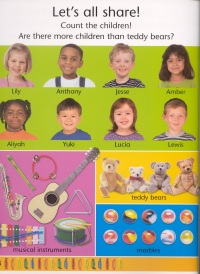| ________________
CM . . .
. Volume IX Number 19 . . . . May 23, 2003
excerpt:
A complementary volume to My World: A First Word Book, My World Numbers: A First Counting and Math Book focuses on 10 key math skills: counting, sequencing, connections, patterns, matching, relationships, calculating, shapes, space and measures. To assist the adults who will be using the book with children, each skill is matched with a symbol, and the appropriate symbols appear at the top of pages to identify which concepts are being covered by the activities on that page.
Since the book was not designed to be consumed by children in one extended sitting, it is essential that the adults who will be sharing the work’s contents with children do take the time to read and absorb the “Using this book” portion of the “Notes to parents & caregivers,” especially noting the cautionary advice that “it is important to create a relaxed atmosphere, allowing a child to set his or her own pace.” In the main, each pair of facing pages focuses on introducing one math skill while perhaps reinforcing earlier skills. For example, the opening pair of pages deals with counting from 1 to 10 and the next pair advances to counting from 11 to 20. A later pair of pages is concerned with the skill of sequencing and does so in two different ways. One page omits numbers in a sequence and invites the child reader to insert the missing numbers while the second page has numbered objects, but they are out of order, and the child is invited to sequence them. While each concept section provides questions that the adult reader is invited to use as starting points, much room is left for adult creativity. For instance, on the “Count from 11 to 20!” pages, the book offers the question. “How many toy cars can you see?”; however, the facilitating adult could add, “How many are yellow?” or “How many are convertibles?” or “How many have racing stripes?” The volume’s full colour photographs, in addition to being multi-racial, are child friendly in that they portray items, such as toys, foods, clothing and animals, that will be known to and recognized by most children. In the event that they are not, the objects are also labeled. Very occasionally, the book’s original British origin does intrude, such as on page 9 where the 17 erasers contain eraser shapes that will likely not be recognized by North American child readers who, without adult intervention, may identify some of them as candies. Some adults may not see the tasks in the book’s closing pages as being immediately connected to mathematics. For example, the “My day” page divides (or sequences) the day into morning, daytime, evening and nighttime and then shows a dozen objects and asks the child, “At what time of day do you use these things?” Interestingly, many of them, such as the bar of soap, a loaf of bread and a bicycle, could fit into the sequence a number of times. The discussion which could ensue would enrich a child’s language development as well as her/his abilities to generalize sequence to settings beyond just numbers. Another pair of closing pages introduces children to 15 shapes, both two and three dimensional, and then asks them to identify these shapes in their everyday object forms. Finally, those children who want to practice their counting can take advantage of an interesting additional feature to this 32 page book. Arranged horizontally at the bottom of each page and immediately adjacent to the page number are a number of objects which correspond to that page’s number. Given that “math readiness” merits equal concern with “reading readiness,” My World Numbers: A First Counting and Math Book should be in home collections and day cares, as well as in all libraries serving preschoolers. Highly Recommended. Dave Jenkinson teaches courses in children’s and adolescent literature at the Faculty of Education, the University of Manitoba.
To comment
on this title or this review, send mail to cm@umanitoba.ca.
Copyright © the Manitoba Library Association. Reproduction for personal
use is permitted only if this copyright notice is maintained. Any
other reproduction is prohibited without permission.
NEXT REVIEW |TABLE OF CONTENTS FOR THIS ISSUE - May 23, 2003. AUTHORS | TITLES | MEDIA REVIEWS | PROFILES | BACK ISSUES | SEARCH | CMARCHIVE | HOME |

